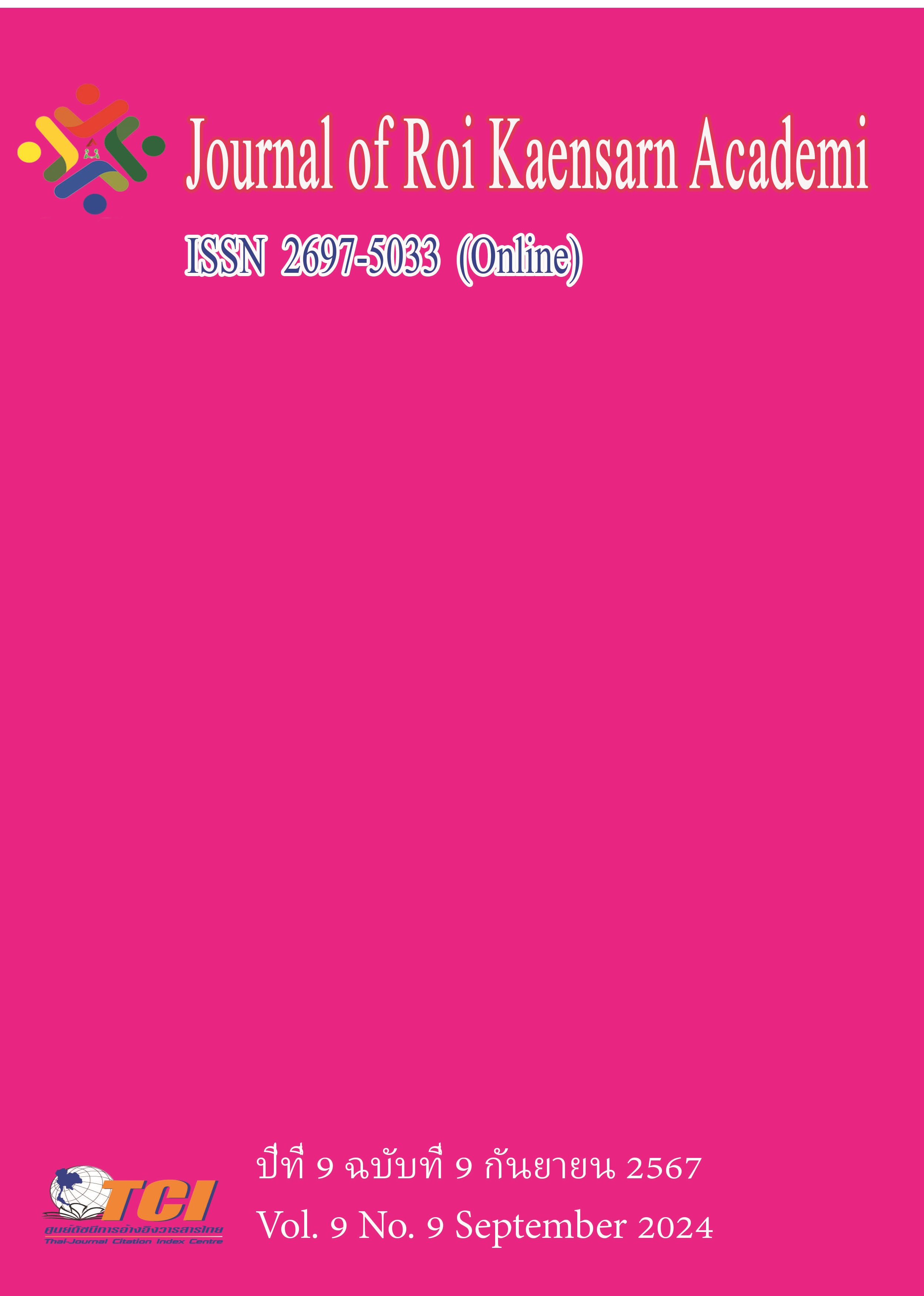The Investigating Tactile Experiences and Textures with Sustainable Materials in Art and Design Education
Main Article Content
บทคัดย่อ
This research investigates how tactile experiences with sustainable materials influence educational outcomes, emphasizing how interacting with these materials can enhance students' creativity, learning experiences, and increase awareness of sustainability. Traditional discussions have focused on the environmental benefits of these materials, often neglecting their educational and experiential value.
This study aims: (1) to explore tactile experiences with various sustainable materials; (2) to examine these materials through experiential learning practices; and (3) to measure students’ agreement using a questionnaire on tactile experiences with sustainable materials in educational settings, thereby promoting a participatory and tactile-focused learning approach.
This study employed a mixed-methods approach, including in-depth interviews with three art and design experts, three participatory workshops, and questionnaires to collect data. The research involved 48 student participants in three participatory workshops, enabling an analysis of their tactile interactions with sustainable materials.
In the results, descriptive analysis showed the significant role of textures in enhancing the appeal of tactile experiences and the impact of sustainable materials on these experiences, thereby enriching educational engagement. The majority of student participants recognized the value of using sustainable materials in art and design education, indicating a better understanding and awareness. However, students' application of sustainable materials to art projects was limited.
In conclusion, the study highlights the educational and experiential value of tactile interactions with sustainable materials in art and design education. Integrating these materials can increase tactile experiences, sustainability awareness, and students’ engagement. This research addresses the gap in the existing literature and recommends conducting further research and assessment of practical applications in the field.
Article Details
เอกสารอ้างอิง
Atkinson, D., Barley, S., Petreca, B. B., Bianchi-Berthouze, N., & Watkins, P. (2016). The tactile triangle: A design research framework demonstrated through tactilecom parisons of textile materials. Journal of Design Research, 14 (2), 142-170. https:// doi.org/10.1504/JDR.2016.077015
Alerby, E., & Opstad, K. D. (2022). Texture and (arts) education: Encouraging attention, awareness and sensitivity. European Journal of Philosophy in Arts Education, 7 (1), 7-37. https://doi.org/10.5281/zenodo.6536166
Allwood, J. M. (2016). Sustainable materials. Nature Reviews Materials, 1(1), 1-2. https://doi. org/10.1038/natrevmats.2015.9
Cheng, V. M. (2018). Views on creativity, environmental sustainability and their integrated development. Creative Education, 9 (5), 719-743.
Chiang, I.-Y., Lin, P.-H., & Lin, R. (2023). Haptic cognition model with material experience:
Case study of the design innovation. In P.-L. P. Rau (Ed.), Cross-cultural design:Experience and product design across cultures (pp. 180-193). Springer.https:/ doi.org/10.1007/ 978-3-031-35939-2_14
Coppola, V., Graziano, A. M., Inguì, G., & Tonini, G. (2018). Restoration treatment on Palatine Chapel’s mosaic floor in Palermo: The use of a new material for lacunae integration. In Dialogues en Cultural Heritage: Book of abstracts of the VI international conference Yococu, Matera 22-26 May 2018 (pp. 341-344).
YOCOCU CNR–IBAM (Istituto per i Beni Archeologici e Monumentali). https:// www.academia.edu/download/74224191/BOOKYOCOCU2018.pdf#page=365
Ferreira, B. M. (2019). Packaging texture influences product taste and consumer satisfac tion.Journal of Sensory Studies, 34(6), e12532. https://doi.org/10.1111/ joss. 12532
Gallace, A., & Spence, C. (2011). Tactile aesthetics: Towards a definition of its characteristicsand neural correlates. Social Semiotics, 21(4), 569-589. https:// doi.org/10.1080/10350330.2011.591998
Grant, P., & Mason, T. (2013). New and advanced materials. Government Office for Science.https://assets.publishing.service.gov.uk/media/5a7c1485e5274a25a9140543/ep10-new-and-advanced-materials.pdf
Hart, A. (2020). Mini-review of waste shell-derived materials’ applications WasteManagement & Research, 38 (5), 514-527. https://doi.org/10.1177/0734242X19897812
Halada, K., Yamada, K., Ijima, K., & Soeno, Y. (2003). Analysis of the current statusof ecomaterials in Japan.Materials Transactions, 44 (7), 1237-1243.https:// www.jstage.j st.go.jp/article/matertrans/44/7/44_7_1237/_pdf
Hofverberg, H., & Westerlund, S. (2021). Among facilitators, instructors, advisors, and educators – How teachers educate for sustainability in design and craft education. International Journal of Art & Design Education, 40 (3), 543-557. https://doi. org/10.1111/jade.12366
Karana, E., & Nijkamp, N. (2014). Fiberness, reflectiveness, and roughness in the character ization of natural and high-quality materials. Journal of CleanerProduc tion, 68, 252-260. https://doi.org/10.1016/j.jclepro.2014.01.001
Kolb, D. A. (1984). Experiential learning: Experience as the source of learning and develop ment. Upper Saddle River, NJ: Prentice Hall.https://learningfromexperie nce.com /themes/experiential-learning-book-excerpt.pdf
Meng, Z. (2010, November). Detailed analysis of the human-touch in advertisement design. In 2010 IEEE 11th International Conference on Computer-Aided Industrial Design & Conceptual Design 1 (Vol. 2, pp. 1039-1042). IEEE. https://doi.org/10.11 09/CAIDCD.2010.5681836
Nicolau, A. M. (2023). Sustainable Perspectives Using Human Beings: The Sensory Propertiesof a Bio-Based Material Compared to a Synthetic Material—An Overall Assessment
Based on an Innovative Blind Method. Sustainability, 15 (12), 9145.
Numa, K., Toriumi, K., Tanaka, K., Akaishi, M., & Hori, K. (2008). Participatoryworkshop as a creativity support system. In Knowledge-Based Intelligent Informationand Engi neering Systems: 12th International Conference, KES 2008, Zagreb, Croatia, Septem ber 3-5, 2008, Proceedings, Part II 12 (pp. 823-830). Springer BerlinHeidelberg. https://doi.org/10.1007/978-3-540-85565-1_102
Parisi, S., Rognoli, V., & Sonneveld, M. (2017). Material tinkering. An inspirational approachfor experiential learning and envisioning in product design education. The DesignJournal, 20(sup1), S1167-S1184. https://doi.org/10.1080/14606925. 2017.135 3059
Rognoli, V. (2010). A broad survey on expressive-sensorial characterization of materials for design education. METU Journal of Faculty of Architecture, 27 (2), 287-300. https: //doi.org/10.4305/METU.JFA.2010.2.16
Shao, W. (2019, October). On the surface texture effect of ceramic materials. In IOP Con ference Series: Materials Science and Engineering (Vol. 612, No. 3, p. 032122). IOP Publishing. https://doi.org/10.1088/1757-899X/612/3/032122
Stevens, N. S., & Culén, A. L. (2024). Toward sustainable futures by design education. Sustainability, 16 (16), 6777. https://doi.org/10.3390/su16166777
Sonneveld, M. H. (2007). The aesthetics of tactual experience: About the body language ofobjects. Thesis. Delft University of Technology, Delft. https://pure.tudelft.nl/ ws/portalfiles/portal/141401218/Aesthetics_of_tactual_experience.pdf
Umezawa, O., Shinohara, Y., & Halada, K. (2014). New aspects of ecomaterials from theviewpoints of the consumer and regional communities. Materials Transactions, 55 (5),745–749. https://doi.org/10.2320/matertrans.MB201302
Utsugi, N., Yiyin, S., Abe, M., & SHIRASHI, T. (2007). Visual character of board-form edenvironment conscious materials. In International Association of Societies of Design Research Conference, Hon-Kong, Polytechnic University (pp. 1–15). Hong Kong.https://www.sd.polyu.edu.hk/iasdr/proceeding/papers/Visual%20Character%20of%20Board-formed%20Environment%20Conscious%20Materials.pdf
Zuo, H., & Jones, M. (2005, May). Exploration into formal aesthetics in design: (material) texture. In Proceedings of 8th Generative Art Conference, Milan (Vol. 220). https:// www.generativeart.com/on/cic/papers2005/15.HengfengZuo.htm

